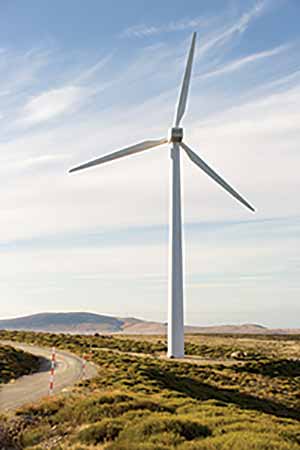Wind energy has emerged as a pivotal player in the global shift towards sustainable and renewable energy sources. Wind turbines, a cornerstone of wind energy production, rely on various components for efficient and reliable operation. Among these components, bearings play a crucial role in ensuring the smooth functioning and longevity of wind mills. This article explores the significance of bearings in wind turbines, shedding light on their key functions, types, and the impact they have on overall performance.
Load Support and Rotation
Bearings are fundamental for supporting the heavy loads and enabling the rotation of various components within a wind turbine. The main shaft, gearbox, and generator all rely on bearings to distribute the loads evenly, minimizing friction and wear. This load support is essential for the seamless rotation of the turbine blades, ensuring optimal energy production.
Blade Pitch Control
Modern wind turbines often feature adjustable blade pitch systems that optimize energy capture under different wind conditions. Bearings are integral to these pitch control mechanisms, facilitating the precise adjustment of blade angles. This capability is crucial for maximizing energy output and protecting the turbine during extreme wind events.
Yaw System and Directional Control
The yaw system is responsible for orienting the turbine rotor into the wind to capture maximum energy. Bearings enable the smooth rotation of the yaw system, allowing the turbine to align itself with changing wind directions. Efficient bearings contribute to precise and responsive directional control, enhancing overall energy production.
Gearbox Functionality
Wind turbine gearboxes are complex assemblies that transfer power from the slow-turning rotor to the high-speed generator. Bearings within the gearbox support shafts and gears, minimizing friction and ensuring efficient power transmission. Robust and reliable bearings are critical for preventing premature wear and ensuring the longevity of the gearbox.
Maintenance and Reliability
The remote locations of many wind farms make maintenance a challenging and costly endeavor. Bearings with high durability and low maintenance requirements are essential for minimizing downtime and extending the lifespan of wind turbines. Advances in bearing technology, such as condition monitoring systems, enable predictive maintenance, reducing the risk of unexpected failures.
Environmental Considerations
Wind turbines are exposed to harsh environmental conditions, including temperature variations, moisture, and wind-induced vibrations. Bearings designed to withstand these conditions are vital for ensuring the longevity and reliability of wind turbines in diverse climates.
Conclusion: In the realm of wind energy, bearings emerge as unsung heroes, playing a pivotal role in the reliable and efficient operation of wind mills. As the demand for clean and sustainable energy continues to grow, advancements in bearing technology will contribute to the overall performance and viability of wind turbines, making them an indispensable component in the global pursuit of a greener future.
Demand for wind mill bearings in India![Wind-Mill]()
Here below are some general trends and considerations relevant to the demand for wind mill bearings in India:
Growing Wind Energy Sector: India has been actively investing in renewable energy, including wind power. The country has witnessed a significant growth in its wind energy sector, with various government initiatives and incentives to promote clean energy. This growth directly impacts the demand for components such as bearings in the wind turbine.
Increasing Wind Capacity: India has set ambitious targets for expanding its wind energy capacity. The government’s commitment to increasing the share of renewables in the energy mix has led to a rise in the installation of wind turbines, subsequently driving the demand for associated components like bearings.
Importance of Reliable Components: The reliability and efficiency of wind turbines are critical factors for the success of wind energy projects. As a result, there is a heightened focus on using high-quality bearings that can withstand the operational demands and environmental conditions specific to the Indian subcontinent.
Local Manufacturing and Supply Chain: To meet the growing demand and reduce dependency on imports, there has been an emphasis on local manufacturing and strengthening the supply chain for wind energy components, including bearings. This approach aims to enhance the availability and affordability of essential parts.
Technological Advancements: Advances in bearing technology, including innovations in materials and design, are likely to impact the demand for bearings in wind mills. Bearings that offer improved efficiency, durability, and reduced maintenance requirements are likely to be sought after in the Indian market.
Meeting Demands Indigenously
India has been making efforts to meet the demands of the wind energy sector, including the production of essential components like bearings, indigenously. Here are some factors to consider:
Local Manufacturing Initiatives: The Indian government has been encouraging local manufacturing in the renewable energy sector, including wind energy. Policies and incentives are often designed to boost the production of wind turbine components within the country.
Domestic Production of Bearings: India has a well-established industrial base and a growing manufacturing sector. Several companies in India are involved in the production of bearings, and some are specifically catering to the needs of the wind energy sector. These companies contribute to meeting the demand for bearings within the country.
Strengthening the Supply Chain: To reduce dependence on imports and enhance self-sufficiency, efforts have been made to strengthen the entire supply chain for wind turbine components. This includes the sourcing of raw materials, manufacturing processes, and the availability of critical components like bearings.
Collaboration with Global Players: Some Indian companies in the bearing and wind energy sectors collaborate with global players to access advanced technologies and ensure the production of high-quality components. Such collaborations contribute to improving the competitiveness of domestically produced bearings.
Investments in Research and Development: Research and development (R&D) initiatives are crucial for advancing technology and meeting the evolving demands of the wind energy sector. Investments in R&D help enhance the quality and efficiency of locally manufactured bearings.
Government Policies and Incentives: The Indian government has implemented policies and incentives to promote the indigenous manufacturing of renewable energy components. These measures are aimed at creating a conducive environment for domestic production and reducing reliance on imports.
Conclusion
In the realm of wind energy, bearings emerge as unsung heroes, playing a pivotal role in the reliable and efficient operation of wind mills. As the demand for clean and sustainable energy continues to grow, advancements in bearing technology will contribute to the overall performance and viability of wind turbines, making them an indispensable component in the global pursuit of a greener future.



